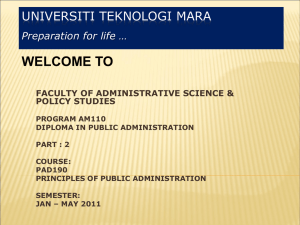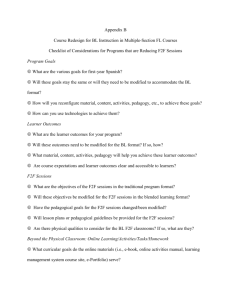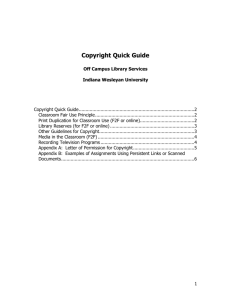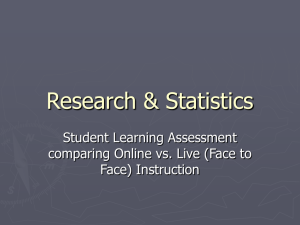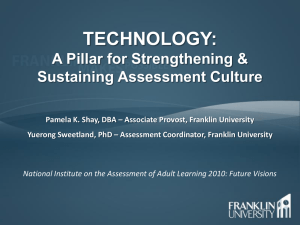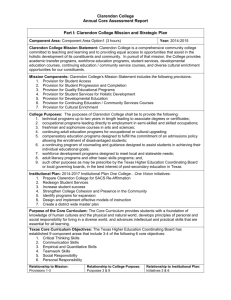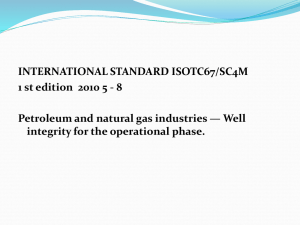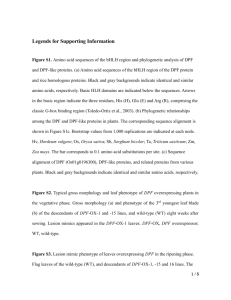Introducing Distance Education to the Technion: Science and
advertisement
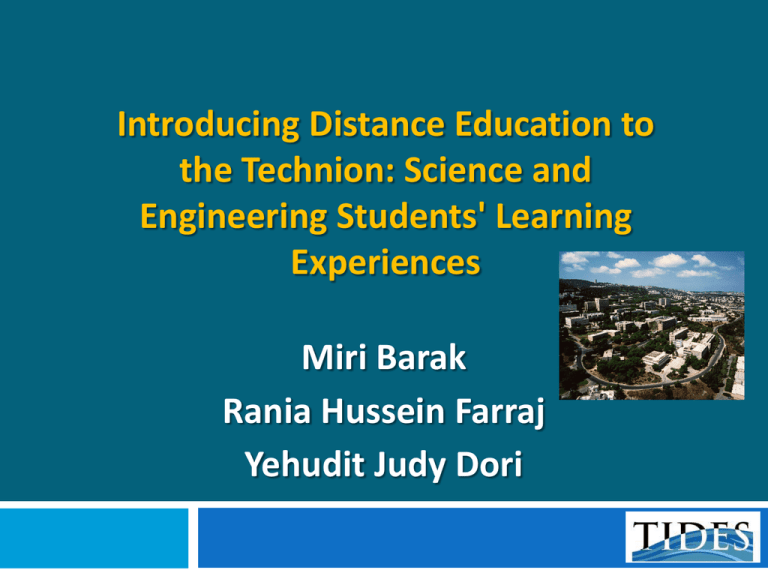
Introducing Distance Education to the Technion: Science and Engineering Students' Learning Experiences Miri Barak Rania Hussein Farraj Yehudit Judy Dori Introduction Universities nowadays reach out to students who are employees of organizations and companies by launching distance education (DE) programs. TIDES - Technion International Distance Education and Studies was established by Prof. Dori, Head of the Division of Continuing Education and External Studies. TIDES aims at enhancing lifelong learning among graduates engineers and scientist while contributing to their professional development and productivity. Distance Education (DE) in Higher Education DE is defined as learning through a variety of technological means, enabling students far away from the teaching place to acquire knowledge as if they were present at the face-to-face (F2F) lessons (Schrum & Ohler, 2005). DE systems offer learners flexibility; learning can be conducted at the same time - synchronously, or at different times asynchronously (Berge, 2007). Universities invest much effort in developing online environments that promote active learning and high order thinking skills (Hussein Farraj, Barak & Dori, 2011). Distance Education (DE) in Higher Education In the past decade, many universities developed DE programs for attracting and retaining students (Allen & Seaman, 2010; Lee & Pituch, 2006). However, some studies report that the integration of DE in academia faces a wide range of problems, such as : work overload, intellectual property rights , Interactions with students, etc. (Bonk, et al., 2003; Cuban, et al., 2001). Whilst higher education institutions have invested substantial resources in DL, their pedagogical advantages as well as their costeffectiveness are still to be examined. Research Goal and Plan To examine science and engineering students' attitudes about DE and their learning experiences. The research plan included three consecutive stages: The initial stage which was carried out for the purpose of learning about students' attitudes towards distance learning and investigating the feasibility of establishing DE courses in our university. The comparative stage which was conducted in order to examine the effect of DE on students' learning experiences. In this stage we compared between two groups of students: those who studied in a regular classroom setting and those who studied from distance via online tools. The focus stage which led to validation of the quantitative and qualitative findings derived from the second stage and was related to students' learning experiences in a DE setting. Research Settings The Moodle system http://www.moodle.com, an open-source web application, was used as the learning environment for both DE and F2F students. Students' Assignments included online discussions, worksheets, and questionnaires. The lectures were videotaped via Panopto system http://www.panopto.com and were broadcasted asynchronously. Research Participants The initial stage: 261 science and engineering graduate students answered a survey. The comparative stage: 105 students participating in two courses: Innovation Management and From Cell to Tissue Divided into two research groups: On-campus students (N=70) who studied in a traditional setting DE students (N=35) who studied in an online setting. The focus stage: 8 DE students Video Recordings of F2F Lectures The Comparative Stage (N=105) Personal background and demographics Course Gender Age Major Veteran in workplace Student percentage DL F2F Innovation Management 63 43 From Cell to Tissue 37 57 Male 66 43 Female 34 57 20–to-34 years old 55 87 Above 35 years old 45 13 Engineering 55 75 Science 45 25 5 or less 62 81 More than 5 years 38 19 The Focus Stage (N=8) Age group Undergraduate major Gefen > 30 Engineering Ora > 30 Science > 30 Science Meril > 35 Science Yoni > 25 Science Tom > 40 Engineering Adam > 30 Engineering Boris > 40 Engineering Pseudonyms Anat Gender Female Male Workplace Pharmaceutical Company Pharmaceutical Company Pharmaceutical Company High-tec. company (U.S.A) Military industry Engineering company Communication company Engineering Position at workplace Veteran in workplace Engineer 5-10 Team leader 1-5 Team leader 5-10 Manager 1-5 Engineer 5-10 Manager 10-15 Engineer 1-5 Manager 1-5 Method and Tools The Mix Method Research model (Johnston and Onwuegbuzie 2004). The research tools included: Pre- and post- online questionnaires Consisted of open- and close ended questions. The 1-to-5 Likert type scale, included 32 items composing Six categories: a) Promoting meaningful learning, b) Techno-pedagogical benefits, c) Social aspects and communication, d) Course quality and students' support, e) Self-efficacy and self-assurance, and f) Work-place and promotion. Adapted from Schrum & Ohler ( 2005), Shin & Chan, (2004); Pituch & Lee (2006), Cronbach's Alpha, was 0.93. Method and Tools Semi structured interviews Conducted among eight students, audiotaped by Audacity software (http://audacity.sourceforge.net), and lasted about 30 minutes. A researcher diary was used for documenting the interviews and for quality assurance. Findings: The Initial Stage Category Mean (N=261) 3.40 3.74 0.78 0.70 Course quality and student support 2.95 3.06 0.86 0.82 Self-efficacy and self-assurance 3.82 0.82 Workplace and promotion 3.44 0.79 Total 3.40 0.64 Meaningful learning Technological pedagogical benefits Social aspects and communication SD Students with previous experience in DE hold statistically significant higher positive attitudes about DE (t (239) = 3.61, p < 0.001). Findings: The Comparative Stage Research group N F2F DE 70 35 Pre questionnaire Post questionnaire Mean* 3.22 3.54 Mean* 3.12 3.58 SD 0.45 0.64 SD 0.49 0.58 No statistically significant difference was found between the pre- and post-perception questionnaires mean scores for both research groups. However, data indicated that DE students asserted higher positive opinions on the course in comparison with their F2F peers. The DE students asserted statistically significant higher positive opinions about meaningful learning, and self-efficacy and selfassurance (F (1, 74) = 5.37, p<0.05; F (1, 74) = 4.24, p >0.05, respectively). Findings: The Comparative Stage The DE female students, in comparison with males, asserted statistically significant higher positive perceptions of DE related to social aspects and communication in the course (F (1, 33) = 4.77, p < 0.05). It appears that female students were more confident about their ability to communicate with their classmates and lecturers from distance. Findings: The focus stage The Comparative Stage Young DE students, ages 20 to 24, asserted statistically significant higher positive perceptions of the quality of the DE courses and the support received from the teaching staff, in comparison with elderly peers (F(1, 33) = 7.89, p > 0.05(. It may be because younger students are more computer savvy and they feel they do not need much technical support. Findings: The Focus Stage Themes Categories Examples In DE it is the same level of understanding as learning face to face. Thinking skills Cognitive and professional skills Professional skills Regulation of cognition Affective Resource management In DE I can concentrate better when learning on my computer. Self -discipline DE requires self-discipline, that I have, and therefore I have no problem to learn from distance. Interest and challenge When the course team explained to us the method of DE course I was very interested so I decided to participate in this challenging venture. With lecturer DE is a new concept and I wanted to try it. DE does not lack interaction because you can communicate with the lecturer by Email With peers I need to Interact with people. DE does not give the opportunity to participate in discussion with my peers in a real time. Time management DE has opened for me the possibility to study the learning materials at times convenient to me. Innovation Social interaction In DE I work with my colleagues through Skype calls, so we talk to the point and learn to build a professional basis. Environment manage. Learning management DE allows me to choose the learning environment which is good for me. DE is an appropriate learning method for me because I like to manage and plan my own learning. Summary and Implications Our findings indicated that although lifelong learning is crucial for the professional development of graduate students, not all of them are able or willing to study from distance. DE students were more satisfied with their learning compared to the F2F students. However, DE students are concerned with: their self-determination and self-discipline lack of social interactions with peers while learning from distance. DE courses can be further improved by encouraging communication and by enhancing students' social interaction as part of their learning experiences. THANKS To Prof. Shulamit Levenberg and Prof. Miriam Erez for taking part in TIDES initiative
